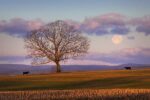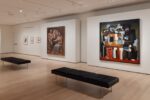La Tarasque, 1874 by Charles Lepec
La Tarasque (1874)
The story behind Lepic’s painting derives from French folklore. In his painting we see Saint Martha riding a creature over the waves. Despite its ferocious look, she has obviously managed to tame it.
What is a Tarasque ?
The tarasque was a mythological monster derived from French folklore. It was a six foot long serpentine beast from Galatia (modern day Turkey). It was a great dragon, half beast and half fish. It was greater than an ox, longer than a horse with teeth sharp as a sword, and horned on either side. It had a head like that of a lion and a serpentine tail. Finally, if that wasn’t bad enough, it could expel a poisonous gas from its mouth.
The picture below shows the beast with an unfortunate person being partly devoured with their legs still dangling from the creature’s mouth. The tarasque dwelt in the woods wood between Arles and Avignon and preyed upon the nearby villagers.
Saint Martha Tames the Beast
Legend has it that Saint Martha was petitioned by local villagers in the town of Nerlucto protect them from the tarasque. When she found the creature it was in the process of devouring a man. By sprinkling holy water and holding up the cross, she caused the creature to become submissive and obedient. She placed leash around its neck and lead the beast to the villagers who cast rocks and spears at it until it died. Thereafter Martha preaches the message of Christianity and the town is renamed Tarascon. The legend makes no mention of the poor half devoured gentleman.
Saint Martha of Bethany is a Christian saint who was likely born in the Judea (Roman Empire) and died in Tarascon, France. She is mentioned in the gospels of Luke and John and is the sister of Lazarus. She and her sister Mary were visited by Jesus according to the gospels of Luke and John. She moved to Avignon around 48AD. Her feast day is July 29.
The Artist
Charles Lepec (1830-90) was a 19th century French painter. He was trained by Jean-Hippolyte Flandrin but ultimately became best-known today for his work in enamel.






